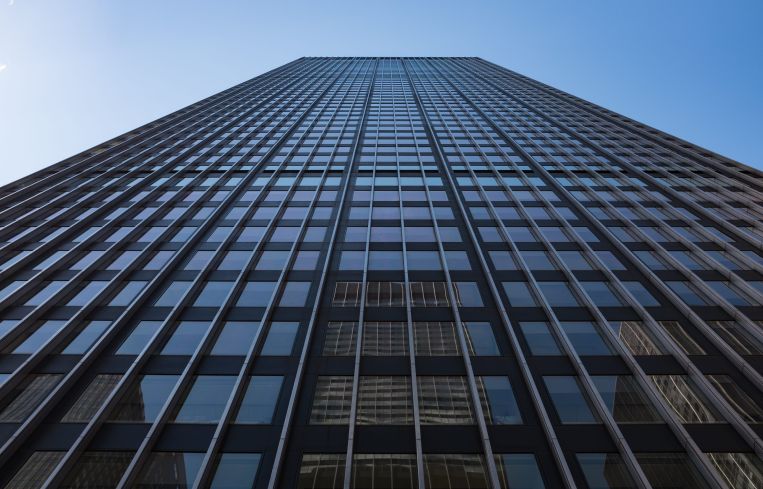JPMorgan Chase’s Jamie Dimon: ‘Remote Work Will Change How We Manage Our Real Estate’
The bank is still committed to occupying the new 270 Park Avenue, where up to 14,000 employees are now expected to work
By Tom Acitelli April 7, 2021 8:16 am
reprints
JPMorgan Chase, the largest U.S. bank by assets and the largest private occupier of office space in Manhattan, expects major changes to its commercial real estate footprint, due to COVID and other factors. That includes reducing the space the bank uses. Still, it intends to finish and to occupy its new 2.5 million-square-foot headquarters at 270 Park Avenue in Manhattan.
“Remote work will change how we manage our real estate,” Jamie Dimon, JPMorgan Chase’s chairman and chief executive, said in his annual message to shareholders, released Wednesday morning.
This change will include a quick shift to what Dimon describes as “a more ‘open seating’ arrangement” for office space and shared space, such as conference rooms. The bank will manage such a move via digital tools, Dimon said.
“As a result, for every 100 employees, we may need seats for only 60 on average,” he said. “This will significantly reduce our need for real estate.”
To be sure, Dimon gave no indication that JPMorgan Chase was switching to a large-scale hybrid work model, wherein most employees would work remotely at least part of the week. And he definitely signaled that the bank was not going all remote. “Some employees” — Dimon’s words — will be working remotely part of the week, and “a small percentage of employees, maybe 10 percent,” will work from home full time “for very specific roles.”
“In all cases, these decisions depend upon what is optimal for our company and our clients, and we will extensively monitor and analyze outcomes to ensure this is the case,” Dimon said. “Of course, we will also continue to reopen following health authority and government guidelines and our own established processes.”
All of this aside, then, for most JPMorgan Chase employees, it will be back to the workplace, including the office, full time at some point. In a March 24 memo to employees, the bank said that, in light of COVID vaccines rolling out, it was hopeful about reopening most, if not all, of its offices during the spring and summer, depending on government health guidelines. The memo also teased some plans that Dimon’s letter makes clearer, such as how many employees might be working remotely.
As with any other clarifications from Dimon regarding JPMorgan Chase’s property needs, the real estate industry in Manhattan in particular will surely be awaiting the oracular word with bated breath.
The bank occupies some 5 million square feet of commercial real estate in Manhattan, and it’s sent some alarming signals for the real estate industry during the pandemic. Perhaps the most alarming came in early March, when Bloomberg broke the news that JPMorgan Chase was seeking to sublet just under 700,000 square feet at 4 New York Plaza in the Financial District, and more than 100,000 square feet at 5 Manhattan West in Hudson Yards.
That’s a remarkable amount of square feet for a Manhattan market already groaning under historic volumes of sublease space. Dimon’s shareholders letter clarifies things, though. He said the bank remains committed to occupying a new 2.5 million-square-foot headquarters at 270 Park Avenue near Grand Central Terminal, which would more than make up for the 800,000 square feet in shed space.
That spire, one of the tallest new office buildings going up in the U.S., is supposed to be finished by mid-decade. That’s around the time most analysts expect Manhattan to have fully recovered from the effects of COVID.
“Finally, we still intend to build our new headquarters in New York City,” Dimon said toward the end of his letter’s section on the real estate fallout from COVID and other factors, such as technological changes and the rise of remote work. “We will, of course, consolidate even more employees into this building, which will house between 12,000 to 14,000 employees. We are extremely excited about the building’s public spaces, state-of-the-art technology, and health and wellness amenities, among many other features. It’s in the best location in one of the world’s greatest cities.”
JPMorgan Chase’s real estate plans follow on the heels of other banks’ similar announcements. Citigroup in March said it was switching to a hybrid model for most employees, though it has not said how that might affect its current office footprint. Morgan Stanley said the same month that it’s planning a “full return” to its Midtown headquarters when it’s safe to do so.
In the end, JPMorgan Chase’s decisions regarding the workplace appear to go beyond what competitors might be doing or what the New York real estate industry wants from its biggest private tenant. Simply put, it expects a growing demand for the sorts of services a large bank provides.
“I have little doubt that with excess savings, new stimulus savings, huge deficit spending, more [quantitative easing], a new potential infrastructure bill, a successful vaccine and euphoria around the end of the pandemic, the U.S. economy will likely boom,” Dimon said in his letter. “This boom could easily run into 2023 because all the spending could extend well into 2023.”


